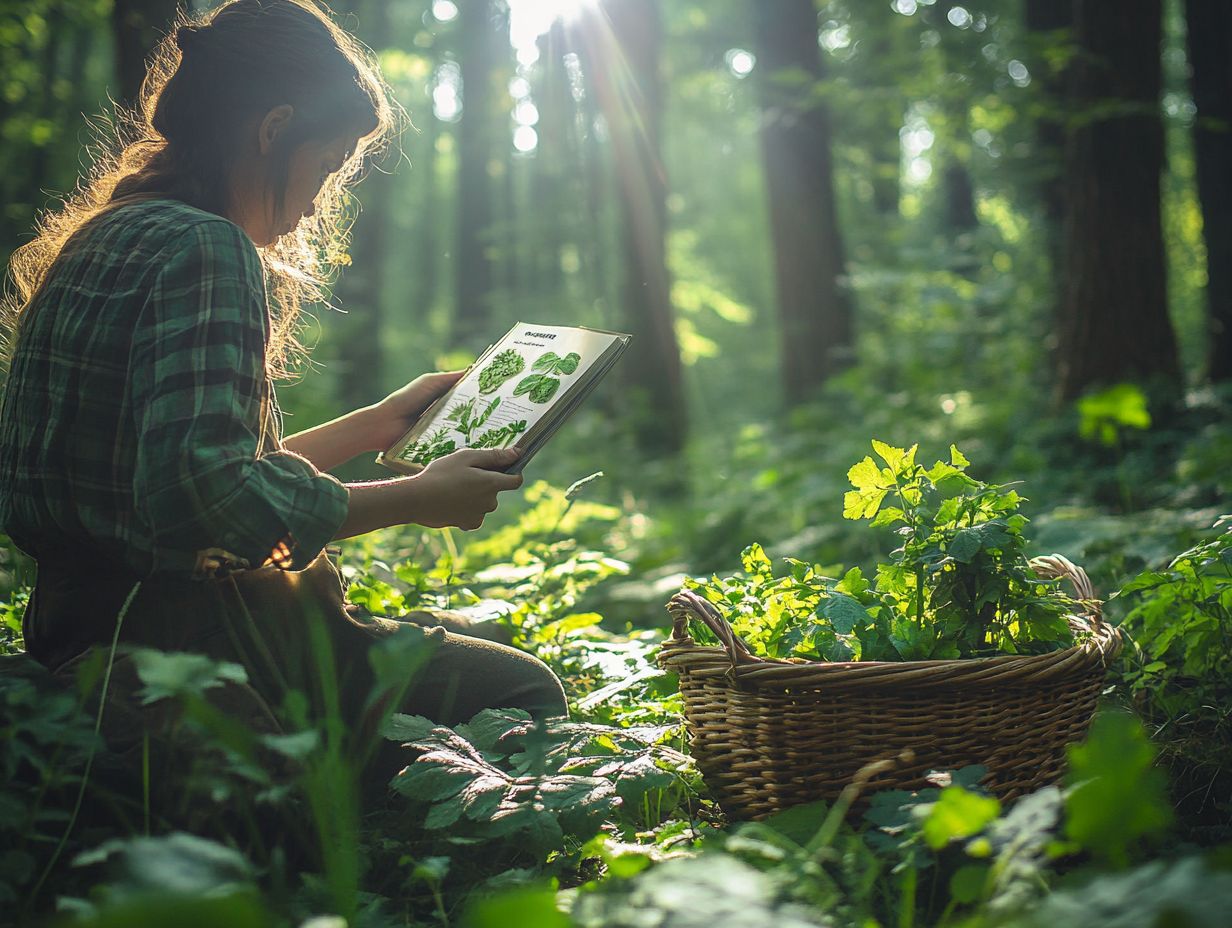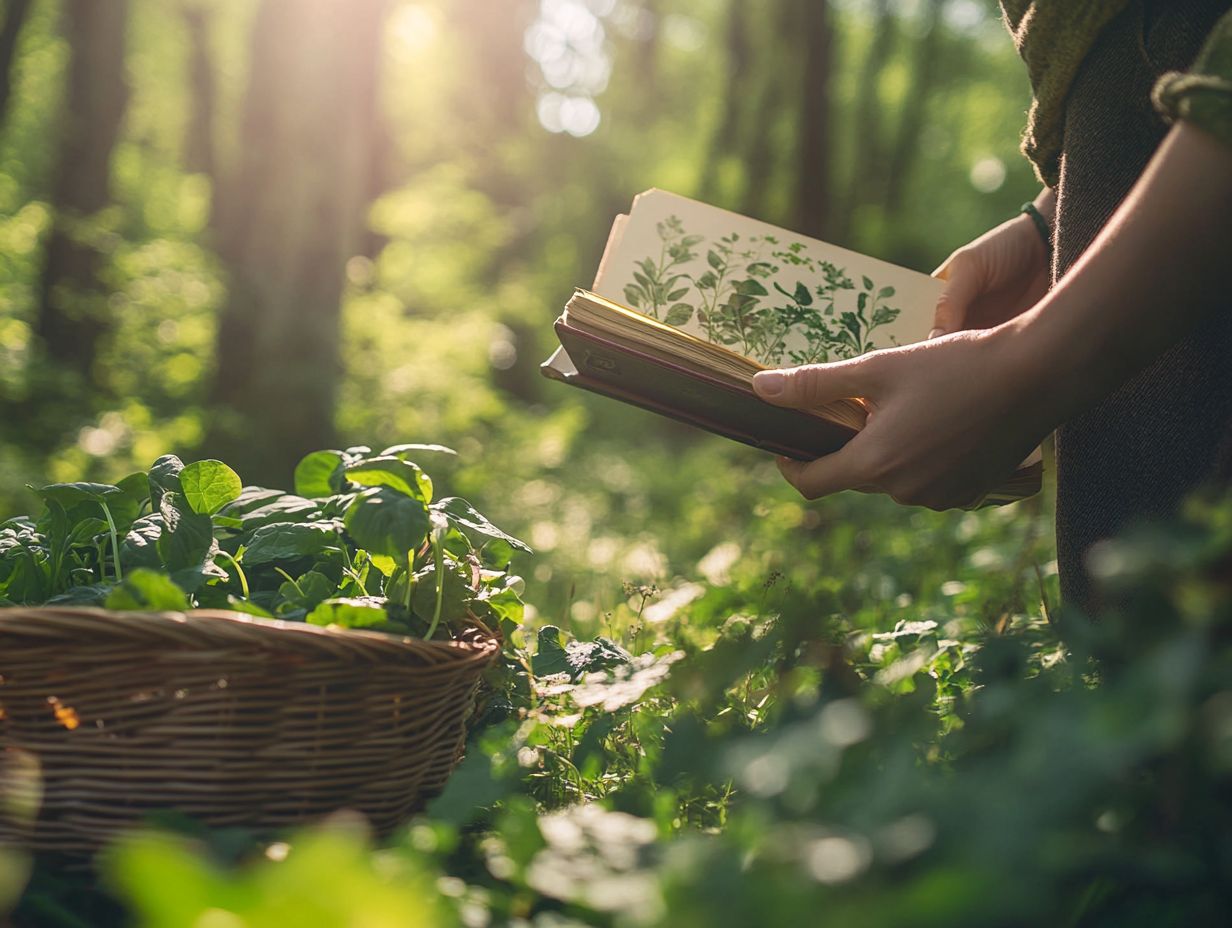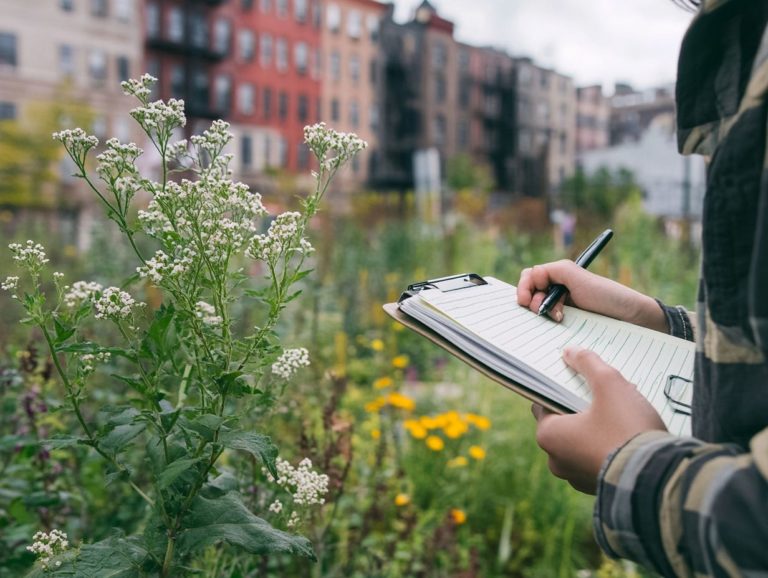How to Spot Edible Plants in the Wild
Exploring the realm of edible plants unlocks a wealth of benefits, enriching your diet while championing sustainability!
Whether you find yourself foraging for wild greens or identifying locally sourced herbs, grasping the nutritional value of these plants can elevate your culinary experiences.
This guide will equip you with the essentials of foraging. You will learn how to safely identify edible varieties, dispel common myths, and prepare them for delightful consumption.
Get ready to discover the amazing treasures nature has waiting for you!
Contents
- Key Takeaways:
- Benefits of Foraging for Edible Plants
- Identifying Edible Plants in the Wild
- Common Misconceptions about Edible Plants
- Preparing and Cooking Edible Plants
- Frequently Asked Questions
- How do I know if a plant in the wild is safe to eat?
- What are some common mistakes people make when trying to identify edible plants in the wild?
- Are there any universal signs that a plant is not edible?
- Can I eat any plant I find in the wild?
- What should I do if I accidentally ingest a poisonous plant?
- Is it safe to eat plants found near roads or urban areas?
Key Takeaways:

- Knowing how to spot edible plants in the wild can provide a sustainable source of nutrition and a fun outdoor activity, encouraging the harvesting of wild berries and nuts.
- Look for key characteristics such as color, texture, and location to identify safe and edible plants, including unique identifiers for aquatic plants.
- Be aware of common misconceptions and safety concerns surrounding edible plants. Always prepare and cook them properly using a simple test to ensure they’re safe to eat.
What are Edible Plants?
Edible plants encompass a diverse range of species, from leafy greens to wild fruits like huckleberries and tree nuts such as hickory and black walnuts. These plants are not just nutritional powerhouses; they also play a crucial role in sustainable foraging practices.
By honing your skills in identifying edible plants in your region and understanding their unique characteristics, you can embark on a rewarding adventure in the wild. Connect with nature while discovering the cooking possibilities they offer.
Recognizing common edible plants, such as dandelions and chickweed, will elevate your cooking techniques and deepen your appreciation for the flavors that wild food can bring. To enhance your skills further, refer to Identifying Safe Edibles: A Forager’s Guide.
The realm of edible plants includes intriguing varieties like wild mushrooms, which boast unique flavors and textures. A delightful assortment of wild berries can enhance your desserts and jams.
The significance of these plants reaches far beyond mere culinary delights; they promote biodiversity and sustainability through foraging.
Engaging with social media groups and participating in plant walks can significantly enrich your knowledge. This fosters a sense of community among enthusiasts who share tips, experiences, and recipes.
This journey of learning nurtures a deeper appreciation for nature and promotes responsible gathering practices. This ensures these valuable resources remain abundant for generations to come.
Benefits of Foraging for Edible Plants
Foraging for edible plants presents a wealth of benefits, from enriched nutritional value to heightened sustainability. It also provides a remarkable opportunity to connect with nature through harvesting wild fruits.
By engaging in this practice, you have the chance to harvest wild plants, including a variety of leafy greens and tree nuts, while exploring diverse flavors. You also cultivate environmental awareness and reduce your dependence on commercial agriculture.
The thrill of discovering edible mushrooms, wild berries, and tree nuts like hickory nuts and black walnuts can be both enlightening and delicious. It nurtures a profound appreciation for the natural world and its culinary treasures.
Nutritional Value and Sustainability
The nutritional value of foraged edible plants often surpasses that of their cultivated counterparts. Wild gems like hickory nuts and black walnuts are not just delicious; they provide essential nutrients and healthy fats.
By incorporating these natural foods into your diet, you enhance your health while supporting sustainability and reducing the carbon footprint linked to commercial farming. Leafy greens, wild fruits, and edible mushrooms can serve as exceptional alternatives to traditional grocery store offerings.
Foraged greens, such as dandelion and purslane, are powerhouses of nutrition, rich in vitamins A, C, and K, along with essential minerals like calcium and iron. These greens make for a nutrient-dense addition to your salads or smoothies.
Wild berries, including blueberries and blackberries, are loaded with antioxidants that fight oxidative stress and contribute to your overall well-being.
Embracing foraging not only allows you to enjoy these health benefits but also positions you as a vital player in protecting different kinds of plants and animals. Collecting native plants helps maintain local ecosystems by supporting pollinators and reducing reliance on monoculture crops.
Excitingly, you can saut foraged mushrooms or add them to soups. They bring unique flavors and a wealth of health benefits to your everyday meals.
Identifying Edible Plants in the Wild

Identifying edible plants in the wild is an essential skill for you as a forager. Learning how to spot edible vs. poisonous plants ensures both safety and a heightened enjoyment of the wild foods around you, especially when it comes to recognizing invasive species.
Key techniques involve recognizing critical characteristics such as leaf shape, flower color, and growth patterns. Equipping yourself with tools like a plant guidebook and employing the universal edibility test, a method to check if a plant is safe to eat, will help you verify the safety of unfamiliar plants. For a more detailed approach, consider learning how to spot edible roots in the wild.
By mastering these identification skills, you can confidently harvest a diverse array of wild plants, including edible varieties and aquatic plants. Learning about identifying edible plants in urban areas enriches your culinary adventures and deepens your understanding of local ecosystems.
Key Characteristics to Look For
When you’re out foraging for wild plants, it’s crucial to recognize key characteristics like leaf arrangement, flower structure, and growth habit. Understanding these traits helps you accurately identify edible plants along trails and keeps you safe from potentially harmful invasive species.
By observing these features in plants such as garlic mustard, dandelions, chickweed, and wild onions, you can responsibly tap into nature’s bounty. For more detailed information, check out identifying wild edibles in your local area. Keep an eye out for subtle variations like leaf serration patterns or stem color, as these can be critical indicators of potential toxicity.
For example, while poison hemlock and wild carrot might look similar at first glance, their differences in flower cluster shape and stem markings are vital for ensuring your safety. To refine your field identification skills, consider joining local foraging groups on social media.
These platforms often provide real-time advice and guidance. Collaborating with seasoned foragers can deepen your understanding of the ecosystem, making your foraging journey both enriching and secure.
Common Misconceptions about Edible Plants
Don t fall for common myths! Many believe all wild plants are safe to eat or that cooking can eliminate toxins. Understanding these truths ensures a safe and enjoyable foraging experience while also appreciating the unique culinary potential of wild foods.
By educating yourself about the realities behind these misconceptions, you can confidently explore the fascinating world of foraging.
So grab your basket and venture into the wild nature s bounty awaits you!
Debunking Myths and Safety Concerns
Debunking myths about foraging is essential for addressing safety concerns and encouraging responsible consumption of wild plants. Misunderstandings about edible mushrooms and a simple test to check if a plant is safe to eat can discourage you from exploring this rewarding practice.
While some plants are edible, others can be harmful, especially invasive species that pose ecological risks and can confuse foragers. Many people mistakenly believe that all wild mushrooms are toxic. In reality, varieties like chanterelles and morels are highly sought after, and learning how to use edible plants in your cooking can enhance your culinary adventures.
Without proper knowledge, you could easily confuse them with poisonous look-alikes, such as the infamous death cap mushroom. The simple test is a vital tool that allows you to safely assess unfamiliar plants before consumption.
Informed foraging practices help you identify beneficial plants like dandelions, garlic mustard, and wild onions, which are packed with nutrients. This knowledge allows you to skillfully avoid harmful species that could jeopardize your health and local ecosystems.
Preparing and Cooking Edible Plants

Preparing and cooking edible plants, including wild fruits, opens up a world of techniques that enhance their flavors and amplify their nutritional benefits.
Imagine using wild fruits like elderberries to craft exquisite jams or incorporating leafy greens such as Pineapple Weed and Japanese Parsley into vibrant salads. The possibilities are limitless!
By mastering cooking techniques, you can transform foraged foods, including wild plants and edible mushrooms, into delightful companions that elevate any dish.
Tips for Safe Consumption
Ensuring safe consumption of foraged edible plants is essential for a rewarding foraging experience. Incorporate practices like the simple test and conduct thorough research on each plant’s characteristics, such as those outlined in our guide on identifying edible plants in Colorado.
Before indulging in any wild plant, it’s vital to prepare them correctly to avoid potential toxicity, enhancing their flavors and promoting your health.
Start the simple test by taking a small sample of the plant and preparing it appropriately, whether by cooking or drying. Consume a piece no larger than a quarter and wait 24 hours to observe any adverse reactions.
Keep track of your findings, noting any symptoms that arise. Researching each plant s cooking methods and nutritional values helps maximize benefits and ensures that any potentially harmful elements are neutralized.
Some plants may need boiling to eliminate toxins, while others might shine in their raw form. Understanding these nuances aids in safe preparations and elevates the flavors of your foraged delights.
Exploring the World of Edible Plants
Exploring the world of edible plants invites you on a captivating journey of discovery and appreciation for nature. Consider participating in plant walks or joining social media groups dedicated to foraging.
This exploration deepens your understanding of local ecosystems and unveils the abundance of wild foods available, from wild berries to aquatic plants. You can also build a community with others who share your interests in foraging and cooking.
Engaging with fellow enthusiasts elevates your experience. Exchange valuable tips, techniques, and personal stories about your foraging adventures. Learning from seasoned foragers accelerates your learning curve and inspires you to experiment with unique recipes that celebrate these seasonal treasures.
By sharing knowledge and culinary creations, you cultivate a sense of camaraderie and respect for nature s bounty, enriching your life with skills that connect you more deeply to your environment.
Frequently Asked Questions
What wild plant will you try foraging first?
How do I know if a plant in the wild is safe to eat?

To determine if a plant is safe to eat, look for clear characteristics, smell, and growth patterns. It’s important to consult the basics of foraging: identifying edibles or an expert to confirm your findings.
What are some common mistakes people make when trying to identify edible plants in the wild?
A common mistake is assuming all plants with berries are safe to eat. This is not true; some poisonous plants also have berries.
Another mistake is misidentifying the plant and confusing it with a poisonous look-alike.
Are there any universal signs that a plant is not edible?
Yes, there are general signs that a plant may not be edible. These include a bitter or unpleasant smell, spines or thorns, and a milky or cloudy sap, which is a thick liquid that can ooze from some plants.
Always identify a plant before consuming it.
Can I eat any plant I find in the wild?
No, not all plants are safe to eat. Some may be poisonous, and others might not provide enough nutritional value.
It s crucial to research and properly identify a plant before eating it.
What should I do if I accidentally ingest a poisonous plant?
If you think you ve ingested a poisonous plant, get medical help right away! Try to identify the plant and bring a sample with you to the hospital. Avoid inducing vomiting unless a medical professional advises you to do so.
Is it safe to eat plants found near roads or urban areas?
It s best to avoid eating plants near roads or in urban areas. These plants could be contaminated with harmful chemicals and pollutants.
Stick to plants found in more natural, untouched areas.






